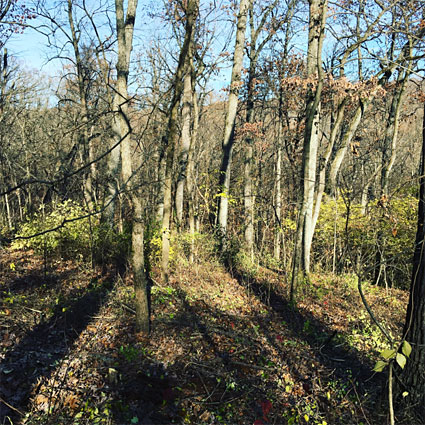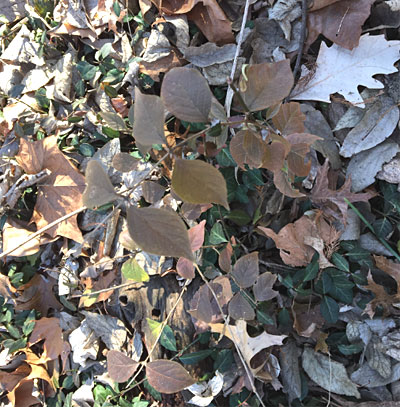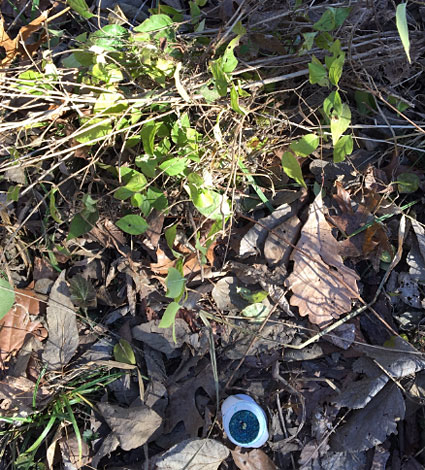Tips for Removing Invasive Honeysuckle
Honeysuckle is one of the last plants to drop leaves in the fall, and one of the first plants to get leaves in the spring. This makes it quite pretty to look at sometimes. A recent photo from Emmenegger Nature Park shows the light green leaves on honeysuckle growing in the understory of a forest in late November.

Unfortunately this characteristic also gives honeysuckle an advantage over other plants. Since many species of honeysuckle are not native and reseed readily, Honeysuckle can be a danger to native plants and plant diversity. Many organizations that are involved with environmental stewardship sponsor volunteer Honeysuckle removal days. I spent a couple of days volunteering recently to remove invasive Honeysuckle from Emmenegger Nature Park in Kirkwood and Litzinger Road Ecology Center in Ladue. If you remove invasive Honeysuckle from your own property you can help stop the spread to other areas. Birds really love to eat the berries and spread the seeds around to places where Honeysuckle is not wanted.
How to Identify Honeysuckle
If you need help with identification, it is very useful to participate in one or two group cleanups so that experts can show you what to look for. After an hour or two of practice you’ll be spotting it everywhere with little effort! Fall is an ideal time for removal because the leaves, being one of the last to persist in the forest, make identification easier.
Look for:
Opposite leaves
Red berries in the fall
Leaves can be green, yellowish, or red/brown depending on the time of year. You may even see it with different colored leaves on the same property on the same day.
Stems are hollow once it gets large enough – snip off a piece to check
Once stems get large enough the bark appears very groovy

If you’re not sure whether your honeysuckle is a undesirable invasive type, you can get help with identification at Missouri Botanical Garden.
How to Remove Honeysuckle
If the plant is small enough, you may be able to just pull it out. Make sure to get the center root clump around the stem or it may grow back. It’s not necessary to get every little piece of root out.
If you can remove the root material from the premises after it’s pulled, do so. If that is not possible hang the plant in a tree off the ground so the roots dry out and die. If you leave the plant on the ground, it may regrow from the roots.
If the plant is too big to pull, dig it out if you can without damaging other plants or causing excessive disturbance of the soil.
If digging is not practical, saw the trunk off as close to the ground as you can. Treat the stub with a 20% solution of glyphosate herbicide. Glyphosate is the active ingredient in Roundup. You can apply it with a bottle that features a dauber attachment, such as a shoe polish bottle or a bingo marker. Or you can spray the glyphosate on the trunk stub. Clearly label bottles, store safely and observe all precautions. You can add dye to the solution to help you keep track of where you have already applied herbicide.
If you can’t remove all the branches from the property, cut them up into smaller pieces so that they lie flat on the ground. Contact with the ground will help the branches decompose faster.
Useful tools to have on hand are a small shovel, a pruning saw, hand pruners and loppers.
You can save yourself a lot of work over time by patrolling your property regularly and removing the Honeysuckle plants while they are still small enough to pull out easily. Once the bushes get to full size, they can still be removed but the job is a lot more labor intensive.

Safety precautions
Wear eye protection, gloves, long sleeves and long pants. You need to protect yourself from scratches, pokes in the eye and chemicals.
Wear work boots or hiking boots with good ankle support – in the woods it’s easy to step in a hole or slip on an uneven surface.
Wear safety orange in case you are in or near a hunting area without realizing it.
Mark your tools with orange tape or paint, because they are easy to lose among the fall leaves on the ground.
After the Honeysuckle is gone, your woods might look a little bare. Don’t worry, there are native plants that can fill the gap and make a healthy as well as lovely contribution to the ecology of your property. Consider planting some of these species instead of Honeysuckle: Some recommended alternatives to bush honeysuckle and other exotic shrubs.
Here is some more information about Honeysuckle:
Bush Honeysuckle
Honeysuckles: For Better or For Worse – There are some species of Honeysuckle that are nice to have – read about them here.
3 replies on “Tips for Removing Invasive Honeysuckle”
[…] Read more on the Schnarr’s Hardware Blog: Tips for Removing Invasive Honeysuckle […]
[…] “Tips for Removing Invasive Honeysuckle”. Schnarr’s Hardware Company, 2017, schnarrsblog.com/tips-removing-invasive-honeysuckle/, Accessed 15 October […]
[…] Shamrock Courts, stone cottages, stone motor court, Sullivanchasenfratz Tom and I are pictured removing invasive honeysuckle and euonymus from the Shamrock Courts in Sullivan, MO. In the center all the volunteers are having […]